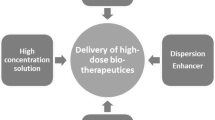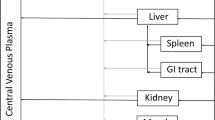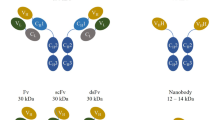Abstract
Purpose. Recombinant human granulocyte-colony stimulating factor (rhG-CSF) was covalently conjugated to both rat and human serum albumin (RSA and HSA respectively) to increases the circulating half life (t1/2) of rhG-CSF.
Methods. Conjugates of RSA (MW 67,000) and HSA (MW 66,000) were prepared by linking the two proteins through a heterobifunctional maleimido-carboxyl polyethylene glycol (PEG) and were tested in the rat. The conjugates were injected intravenously (IV) at the equivalent dose of 50 µg/kg of rhG-CSF, and white blood cell (WBC) counts and plasma concentrations of drug were determined. A comparison of pharmacokinetic parameters was made between rhG-CSF, the conjugates RSA-PEG-rhG-CSF and HSA-PEG-rhG-CSF, and a non-covalent mixture of rhG-CSF and HSA.
Results. The albumin-rhG-CSF conjugates are eliminated more slowly from the circulation. The clearance values are reduced from 0.839 ± 0.121 ml/mm/kg for rhG-CSF to 0.172 ± 0.013 ml/min/kgfor RSA-PEG-rhG-CSF and 0.141 ± 0.005 ml/mm/kg for HSA-PEG-rhG-CSF. WBC counts increased in both absolute number and duration as compared to rhG-CSF alone. The albumin rhG-CSF conjugates had enhanced serum stability relative to free rhG-CSF. The rate of degradation of the albumin conjugates incubated in rat serum at 37°C decreased five fold.
Conclusions. The results from the study show that specific conjugation of rhG-CSF to albumin decreases plasma clearance in vivo, causes increased WBC response, and increases serum stability as compared to free rhG-CSF.
Similar content being viewed by others
REFERENCES
J. E. Layton, H. Hockman, W. P. Sheridan, and G. Morstyn. Evidence for a novel in vivo control mechanism of granulopoiesis: mature cell-related control of a regulatory growth factor. Blood 74:1303–1307 1989.
G. D. Mao and M. J. Poznansky. Superoxide Dismutase: Improving its pharmacological properties by conjugation with human serum albumin. Biomat. Art. Cells. Art. Org. 17(3):229–244 (1989).
M. J. Poznansky, J. Halford, and D. Taylor. Growth hormone-albumin conjugates: Reduced renal toxicity and altered plasma clearance. FEBS Lett. 239(1):18–22 (1988).
M. J. Poznansky. Soluble enzyme-albumin conjugates: New possibilities for enzyme replacement therapy. Methods Enzymol. 137:566–574 (1988).
R. H. Remy and M. J. Poznansky. Immunogenicity and antigenicity of soluble cross-linked enzyme/albumin polymers: advantages for enzyme therapy. The Lancet 2:68–70 (1978).
A. Abuchowski, T. Van Es, N. C. Palczuk, and F. Davis. Alteration of immunological properties of bovine serum albumin by covalent attachment of polyethylene glycol. J. Biol. Chem. 252:3578–3581 (1977).
E. Katchalski, G. S. Benjamin, and V. Gross. J. Am. Chem. Soc. 79:4096–4099 1957.
S. Zalipsky and G. Barnay. Preparation of polyethylene glycol derivatives with two different functional groups at the termini. Polym. Prep Am. Chem. Soc. Div. Polym. Chem. 27(1):1–2 (1986).
L. M. Souza, T. C. Boone, J. Gabrilove, P. H. Lai, K. M. Zsebo, D. C. Murdoch, V. R. Chazin, J. Bruszewski, H. Lu, K. K. Chen, J. Barendt, E. Platzer, M. A. S. Moore, R. Mertlesman, and K. Welte. Recombinant human granulocyte colony-stimulating factor: effects on normal and leukemic meyloid cells. Science 232:61–65 (1986).
T. K. Kirley. Reduction and fluorescent labeling of cyst(e)inecontaining proteins for subsequent structural analyses. Anal. Biochem. 180(2):231–236 1989.
R. W. Niven, K. L. Whitcomb, L. Shaner, L. Ralph, A. D. Habberfield, and J. V. Wilson. Pulmonary absorption of polyethylene glycolated recombinant human granulocyte-colony stimulating factor (PEG rhG-CSF). J. Controlled Rel. 32:77–89 (1994).
M. Gibaldi and D. Perrier. Pharmacokinetics 2nd Edition. Marcel Dekker, New York, 1982.
J. J. Kaneko. Serum Proteins and the Dysproteins. Clinical Biochemistry of Domestic Animals, Fourth edition. Academic Press, Inc., San Diego, 1989.
A. C. Allison. Turnovers of erythrocytes and plasma proteins in mammals. Nature (London) 188:7–40 1960.
P. J. Handagama, M. A. Shuman, and D. F. Bainton. Incorporation of intravenously injected albumin, immunoglobulin G, and fibrinogen in guinea pig megakaryocyte granules. J. Clin. Invest. 84(1):73–82 1989.
A. C. Guyton. Textbook of medical physiology, W. B. Sanders Company, Philadelphia, 1986.
Rights and permissions
About this article
Cite this article
Paige, A.G., Whitcomb, K.L., Liu, J. et al. Prolonged Circulation of Recombinant Human Granulocyte–Colony Stimulating Factor by Covalent Linkage to Albumin Through a Heterobifunctional Polyethylene Glycol. Pharm Res 12, 1883–1888 (1995). https://doi.org/10.1023/A:1016227519561
Issue Date:
DOI: https://doi.org/10.1023/A:1016227519561




